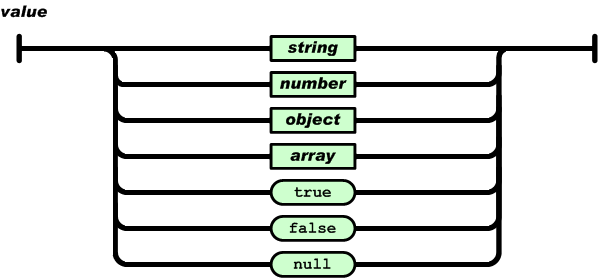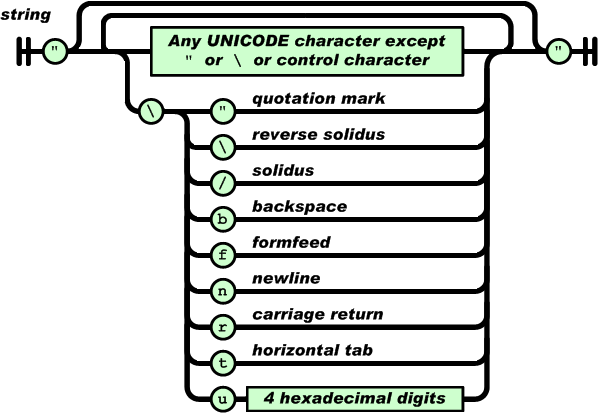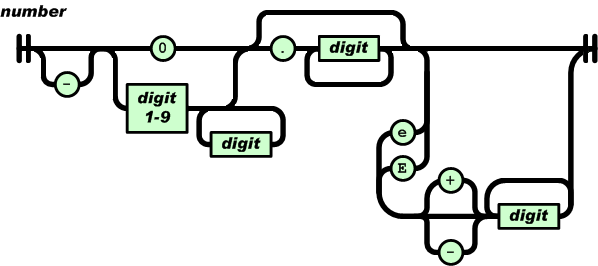转载自http://www.sojson.com/in.html
1 JSON是什么?
JSON是什么?百度百科是这么解释的。
JSON(JavaScript Object Notation) 是一种轻量级的数据交换格式。它基于ECMAScript的一个子集。 JSON采用完全独立于语言的文本格式,但是也使用了类似于C语言家族的习惯(包括C、C++、C#、Java、JavaScript、Perl、Python等)。这些特性使JSON成为理想的数据交换语言。 易于人阅读和编写,同时也易于机器解析和生成(一般用于提升网络传输速率)。
为了不和时代落伍,我们必须要学习 XML 和 JSON,但同时它们也很容易学习。也可以加入我们的JSON大军:QQ群:259217951
XML很好很强大,但是最近有另外一个时代弄潮儿,这就是JSON。现在JSON的光环已经逐渐超越了XML,各大网站提供的数据接口一般都是JSON。下面我们就来学习下JSON。
2 JSON格式
JSON构建于两种结构:
“名称/值”对的集合(A collection of name/value pairs)。不同的语言中,它被理解为对象(object),纪录(record),结构(struct),字典(dictionary),哈希表(hash table),有键列表(keyed list),或者关联数组(associative array)。
值的有序列表(An ordered list of values)。在大多数语言中,它被理解为数组(array)、矢量(vector), 列表(list)或者是序列(sequence)。
JSON具有以下这些形式:
对象是一个无序的“’名称/值’对”集合。一个对象以“{”(左括号)开始,“}”(右括号)结束。每个“名称”后跟一个“:”(冒号);“‘名称/值’ 对”之间使用“,”(逗号)分隔。

数组是值(value)的有序集合。一个数组以“[”(左中括号)开始,“]”(右中括号)结束。值之间使用“,”(逗号)分隔。




数字(number)类似C或者Java里面的数,没有用到的8进制和16进制数除外。
字符串(string)是由0到多个Unicode字符组成的序列,封装在双引号(”“)中, 可以使用反斜杠(‘\’)来进行转义。一个字符可以表示为一个单一字符的字符串。
值(value)可以是双引号括起来的字符串(string)、数值(number)、true、false、 null、对象(object)或者数组(array)。这些结构可以嵌套。
3 举个栗子
上面关于JSON讲了这么多,大家都表示一头雾水了吧?
没关系,我们来举个栗子,让大家有个直观的感受:–)
以目前视频使用的iQiyi提供的频道接口为例:
iQiyi提供的电影频道的JSON电影数据如下:
{"code": 1, "data": 0, "albumIdList": [ { "totalidnum": 2000, "idlist": [ "319281600" ] } ], "albumArray": { "319281600": { "_as": "", "_blk": 0, "_cid": 1, "_ct": "2014-10-10 17:55:06", "_da": "", "_dl": 0, "_dn": "7296", "_id": 319281600, "_img": "http://pic2.qiyipic.com/p_w_picpath/20141016/19/ca/v_108628048_m_601_m1_120_160.jpg", "_ip": 1, "_ma": "", "_pc": 2, "_pid": 0, "_reseftv": 959, "_t": "末代独裁", "_tvct": 1, "_tvs": 1, "_vt": 0, "a_av": 1, "a_pro": "", "bpt": "0", "clm": "", "cn_year": "0", "co_album_id": "0", "ctype": 0, "desc": "", "down": 0, "down2": "0", "drm": 0, "fst_time": "2014-10-16", "h1_img": "http://pic2.qiyipic.com/p_w_picpath/20141016/19/ca/v_108628048_m_601_m1_180_236.jpg", "h2_img": "http://pic2.qiyipic.com/p_w_picpath/20141016/19/ca/v_108628048_m_601_m1_195_260.jpg", "is_h": 0, "is_n": 0, "is_zb": 0, "k_word": "", "language": 0, "live_center": 0, "live_start_time": 0, "live_stop_time": 0, "logo": 1, "m_av": 1, "p_av": 1, "p_s": 0, "p_s_1": 0, "p_s_4": 0, "p_s_8": 0, "qiyi_pro": 0, "qiyi_year": "0", "qt_id": "1005722", "s_TT": "", "songname": "", "t_pc": 1, "tag": "当代 美国 乡村 大片", "tv_eftv": 1, "tv_pha": "", "tv_pro": "", "tv_ss": "", "tvfcs": "雄心壮志背后的真相", "up": 0, "up2": "0", "upcl": "", "v2_img": "http://pic2.qiyipic.com/p_w_picpath/20141016/19/ca/v_108628048_m_601_m1_284_160.jpg", "v3_img": "http://pic2.qiyipic.com/p_w_picpath/20141016/19/ca/v_108628048_m_601_m1_480_270.jpg", "vv": "1", "year": "2007", "tv_id": "0", "vv_p": 0, "vv_f": 2, "vv_m": 0, "_sc": 8 } }, "changeAlbum": null, "category": null, "before": "2~4~1~7~3", "latest_push_id": "655", "up_tm": "1413441370874", "recommend_attach": "", "preset_keys": null, "category_group": null, "exp_ts": 120, "stfile_path": "/data/view/online5/0/1/2.1.8.5.1.txt"}从上面的例子可以很清晰的看出JSON是如何展示一个电影的数据的,当然这是JSON格式化之后的数据。JSON的元数据是不便于阅读的。
4 如何解析JSON?
Android JSON所有相关类,都在org.json包下。
包括JSONObject、JSONArray、JSONStringer、JSONTokener、JSONWriter、JSONException。
<1>. 常见方法
目前JSON解析有2种方法,分别是get和opt方法,可以使用JSON
那么使用get方法与使用opt方法的区别是?
JsonObject方法,opt与get建议使用opt方法,因为get方法如果其内容为空会直接抛出异常。不过JsonArray.opt(index)会有越界问题需要特别注意。
opt、optBoolean、optDouble、optInt、optLong、optString、optJSONArray、optJSONObject get、getBoolean、getDouble、getInt、getLong、getString、getJSONArray、getJSONObject
<2>. Android中如何创建JSON?
在Android中应该如何创建JSON呢?
下面展示了一个如何创建JSON的例子:
private String createJson() throws JSONException { JSONObject jsonObject = new JSONObject(); jsonObject.put("intKey", 123); jsonObject.put("doubleKey", 10.1); jsonObject.put("longKey", 666666666); jsonObject.put("stringKey", "lalala"); jsonObject.put("booleanKey", true); JSONArray jsonArray = new JSONArray(); jsonArray.put(0, 111); jsonArray.put("second"); jsonObject.put("arrayKey", jsonArray); JSONObject innerJsonObject = new JSONObject(); innerJsonObject.put("innerStr", "inner"); jsonObject.put("innerObjectKey", innerJsonObject); Log.e("Json", jsonObject.toString()); return jsonObject.toString();}其输出结果如下所示(JSON格式化后的结果):
{ "intKey": 123, "doubleKey": 10.1, "longKey": 666666666, "stringKey": "lalala", "booleanKey": true, "arrayKey": [ 111, "second" ], "innerObjectKey": { "innerStr": "inner" }}<3>. 如何解析JSON?
下面以视频中解析iQiyi的每个视频album数据为例来说明如何解析JSON:
第一步,需要从网络服务器上发起请求,获取到JSON数据:
JsonObjectRequest jsonObjRequest = new JsonObjectRequest(Request.Method.GET, url, null, new Response.Listener<JSONObject>() { @Override public void onResponse(JSONObject response) { try { MyLog.d(TAG, "response=" + response); parseiQiyiInterfaceResponse(response); } catch (Exception e) { e.printStackTrace(); } } }, new Response.ErrorListener() { @Override public void onErrorResponse(VolleyError error) { /* * if (error instanceof NetworkError) { } else if (error * instanceof ClientError) { } else if (error instanceof * ServerError) { } else if (error instanceof * AuthFailureError) { } else if (error instanceof * ParseError) { } else if (error instanceof * NoConnectionError) { } else if (error instanceof * TimeoutError) { } */ MyLog.e(TAG, "onErrorResponse, error=" + error); } }) { @Override public Map<String, String> getHeaders() throws AuthFailureError { HashMap<String, String> headers = new HashMap<String, String>(); headers.put("t", iQiyiInterface.getEncryptTimestamp()); headers.put("sign", iQiyiInterface.getSign()); return headers; }};第二步,获取到对应的对应的JSONObject数据:
public void getJsonObjectString(String url) { mQueue = VideoApplication.getInstance().getRequestQueue(); JsonObjectRequest jsObjRequest = new JsonObjectRequest(Request.Method.GET, url, null, new Response.Listener<JSONObject>() { @Override public void onResponse(JSONObject response) { MyLog.e(TAG, "response = " + response.toString()); JSONArray jsonArray = null; JSONObject jsonObject = null; try { jsonObject = response.getJSONObject("response"); jsonArray = jsonObject.getJSONObject("result").getJSONArray("album"); } catch (JSONException e) { e.printStackTrace(); } if (jsonArray == null) { return; } mChannelList = VideoUtils.parseVideoJsonArray(jsonArray); if (isLoading) { isLoading = false; if (mIsGrid) { mChannelGridAdapter.appendChannelVideoInfo(mChannelList); } else { mChannelListAdapter.appendChannelVideoInfo(mChannelList); } } else { if (mIsGrid) { mChannelGridAdapter.setChannelVideoInfo(mChannelList); showOppoGrid(); } else { mChannelListAdapter.setChannelVideoInfo(mChannelList); showOppoList(); } } } }, new Response.ErrorListener() { @Override public void onErrorResponse(VolleyError error) { MyLog.e(TAG, "error = " + error); } }); jsObjRequest.setTag(TAG); jsObjRequest.setShouldCache(true); mQueue.add(jsObjRequest); mQueue.start();}获取到JSON Object之后,就对这个JSONObject进行解析:
private ArrayList parseVideoAlbumJsonObject(JSONObject albumJSONObject, ArrayList albumIdJSONArrayList) { MyLog.d(TAG, "parseVideoAlbumJsonObject, length=" + albumJSONObject.length()); if (albumJSONObject.length() < 1) { return null; } ArrayList<VideoConstant> videos = new ArrayList<VideoConstant>(); try { for (int index = 0; index < albumJSONObject.length(); index++) { VideoConstant video = new VideoConstant(); JSONObject itemJsonObject; itemJsonObject = albumJSONObject.getJSONObject(albumIdJSONArrayList.get(index) .toString()); MyLog.d(TAG, "string=" + albumIdJSONArrayList.get(index).toString()); video.mAlbumId = itemJsonObject.optString(InterfaceParameterName.ID); video.mAtitle = itemJsonObject.optString(InterfaceParameterName.TITLE); video.mEpisodeCount = itemJsonObject.optString(InterfaceParameterName.UPDATE_SET); video.mTvSets = itemJsonObject.optString(InterfaceParameterName.TV_SETS); video.mDesc = itemJsonObject.optString(InterfaceParameterName.DESCRIPTION); video.mCid = itemJsonObject.optString(InterfaceParameterName.CATEGORY_ID); video.mImg = itemJsonObject.optString(InterfaceParameterName.IMG); video.mHighimg = itemJsonObject .optString(InterfaceParameterName.HIGH_RESO_PORT_IMG); video.mHoriImg = itemJsonObject .optString(InterfaceParameterName.HIGH_RESO_HORI_IMG); video.mScore = itemJsonObject.optString(InterfaceParameterName.SCORE); video.mMainActors = itemJsonObject.optString(InterfaceParameterName.MAIN_ACTOR); video.mCreateTime = itemJsonObject.optString(InterfaceParameterName.CREATE_TIME); video.mDuration = itemJsonObject.optString(InterfaceParameterName.DURATION); video.mTag = itemJsonObject.optString(InterfaceParameterName.TAG); MyLog.d(TAG, "id=" + video.mAlbumId + ",title=" + video.mAlbumTitle + ",img=" + video.mHighimg + ",tvsets=" + video.mTvSets); videos.add(video); } } catch (JSONException e) { e.printStackTrace(); } return videos;}<4>. Android JSON解析库
上面介绍都是使用Android提供的原生类解析JSON,最大的好处是项目不需要引入第三方库,但是如果比较注重开发效率而且不在意应用大小增加几百K的话,有以下JSON可供选择:
大家可以去对应的官网下载并学习
三、 JSON vs. XMLJSON和XML就像武林界的屠龙刀和倚天剑,那么他们孰强孰弱?
XML长期执数据传输界之牛耳,而JSON作为后起之秀,已经盟主发起了挑战。
那就让他们来进行PK一下:
<1>. JSON相比XML的不同之处
没有结束标签
更短
读写的速度更快
能够使用内建的 JavaScript eval() 方法进行解析
使用数组
不使用保留字
总之: JSON 比 XML 更小、更快,更易解析。
<2>. XML和JSON的区别:
XML的主要组成成分:
XML是element、attribute和element content。
JSON的主要组成成分:
JSON是object、array、string、number、boolean(true/false)和null。
XML要表示一个object(指name-value pair的集合),最初可能会使用element作为object,每个key-value pair 用 attribute 表示:
<student name="soゝso" age="27"/>
但如个某个 value 也是 object,那么就不可以当作attribute:
<student name="soゝso" age="27"> <address> <country>中国</country> <province>北京市</province> <city>朝阳区</city> <district>北京市朝阳区东四环远洋国际中心A座1906 </district> </address></student>
那么,什么时候用element,什么时候用attribute,就已经是一个问题了。
而JSON因为有object这种类型,可以自然地映射,不需考虑上述的问题,自然地得到以下的格式。
{ "name": "John", "age" : 10, "address" : { "country" : "中国", "province" : "北京市", "city" : "朝阳区", "district" : "北京市朝阳区东四环远洋国际中心A座1906", }}One More Thing…
XML需要选择怎么处理element content的换行,而JSON string则不须作这个选择。
XML只有文字,没有预设的数字格式,而JSON则有明确的number格式,这样在locale上也安全。
XML映射数组没大问题,就是数组元素tag比较重复冗余。JSON 比较易读。
JSON的true/false/null也能容易统一至一般编程语言的对应语义。
XML文档可以附上DTD、Schema,还有一堆的诸如XPath之类规范,使用自定义XML元素或属性,能很方便地给数据附加各种约束条件和关联额外信息,从数据表达能力上看,XML强于Json,但是很多场景并不需要这么复杂的重量级的东西,轻便灵活的Json就显得很受欢迎了。
打个比方,如果完成某件事有两种方式:一种简单的,一个复杂的。你选哪个?
JSON与XML相比就是这样的。
这篇文章只是对XML和JSON这2种目前主流使用的数据格式进行了解释,并系统的学习了其中的语法及如何进行解析,同时在最好针对XML和JSON做了对比,了解其不同点和各自的优势。
期望有需要的朋友有所帮助。
转载请注明出处:http://www.sojson.com/in.html



















